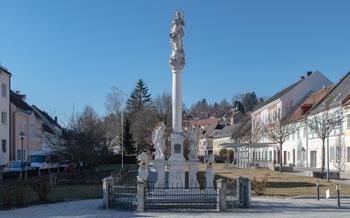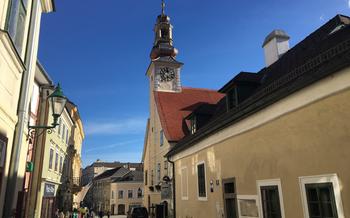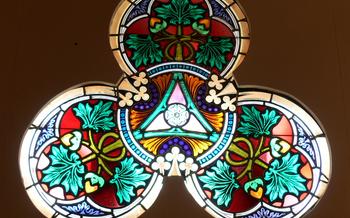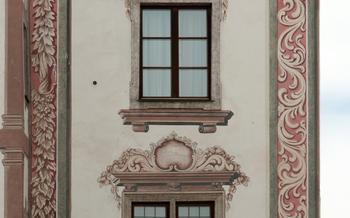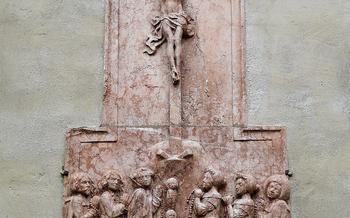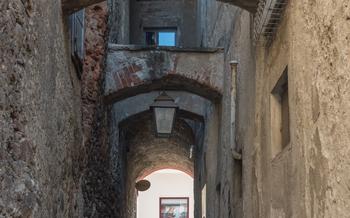
Museum of the History of Dentistry in Upper Austria
- A Journey Through Time: Exploring the Museum of the History of Dentistry in Upper Austria
- Unveiling the Origins of Dentistry: A Glimpse into Ancient Practices
- The Middle Ages: A Period of Stagnation and Superstition
- Renaissance and Enlightenment: A Turning Point in Dental History
- The 19th Century: Advancements in Dental Science and Technology
- 20th Century Innovations: Shaping Modern Dentistry
- A Showcase of Dental Instruments and Equipment
- The Art of Dental Prosthetics: Restoring Smiles
- Oral Hygiene Through the Ages: A Journey of Discovery
- Dental Curiosities and Oddities: Uncovering the Unusual
- Interactive Exhibits: Engaging Visitors of All Ages
- Guided Tours and Educational Programs: Unveiling Dental Secrets
- Museum Shop: A Treasure Trove of Dental Memorabilia
- Insider Tip: A Hidden Gem for Dental Enthusiasts
A Journey Through Time: Exploring the Museum of the History of Dentistry in Upper Austria
Nestled in the heart of Enns, a picturesque town in Upper Austria, lies a hidden gem that takes visitors on a fascinating journey through the evolution of dentistry. The Museum of the History of Dentistry in Upper Austria is a treasure trove of dental artifacts, instruments, and exhibits that tell the story of oral healthcare from ancient times to the present day.
Founded in 1996, the museum is the brainchild of Dr. Helmut A. Niedermayr, a passionate dentist and collector of dental antiques. His vision was to create a space where visitors could learn about the history of dentistry, appreciate the advancements made over the centuries, and gain a deeper understanding of the importance of oral health.
The museum's collection is one of the most comprehensive and significant of its kind in the world. It boasts over 10,000 objects, including ancient dental tools, historical textbooks, rare dental chairs, and a vast array of prosthetic devices. These artifacts provide a unique glimpse into the evolution of dental practices, techniques, and technologies.
The museum's exhibits are organized chronologically, allowing visitors to trace the development of dentistry from its humble beginnings in ancient civilizations to the sophisticated science it is today. Interactive displays and educational panels enhance the visitor experience, making the museum a valuable resource for students, researchers, and anyone interested in the history of dentistry.
Unveiling the Origins of Dentistry: A Glimpse into Ancient Practices
The Museum of the History of Dentistry in Upper Austria takes visitors on a journey through the captivating history of dentistry, starting with its ancient origins. Archaeological evidence reveals that dentistry practices existed in various civilizations across the globe, including the ancient Egyptians, Greeks, Romans, and Chinese. These ancient civilizations displayed remarkable dental knowledge and skills, despite the limited tools and understanding they possessed.
In ancient Egypt, for instance, dentistry was closely linked to religious beliefs and practices. Hieroglyphs depict dental procedures, such as tooth extraction and cavity filling, being performed by skilled healers. The Edwin Smith Papyrus, an ancient Egyptian medical text, contains detailed descriptions of dental treatments, including the use of drills and forceps.
The Greeks and Romans also made significant contributions to early dentistry. Hippocrates, the father of Western medicine, wrote about various dental conditions and their treatments. The Roman physician Celsus described dental procedures in his encyclopedic work De Medicina, including tooth extraction, cavity filling, and the use of dental prosthetics.
Ancient civilizations in the East, such as China and India, also had their own unique dental practices. Chinese medical texts from the Han Dynasty mention the use of acupuncture and herbal remedies for toothaches. In India, the ancient medical treatise Sushruta Samhita describes various dental procedures, including tooth extraction, cavity filling, and the use of dental bridges.
These ancient civilizations laid the foundation for modern dentistry, demonstrating remarkable ingenuity and resourcefulness in addressing dental problems. Their practices and techniques, though limited by the knowledge and technology of the time, paved the way for the advancements that would shape the future of dentistry.
The Middle Ages: A Period of Stagnation and Superstition
The Middle Ages marked a period of relative stagnation in the field of dentistry. Oral health and hygiene were not well understood, and dental problems were often attributed to supernatural causes. Tooth decay and gum disease were rampant, and people often suffered from severe pain and discomfort.
Barbers played a significant role in dentistry during this time. They were responsible for performing tooth extractions, which were often done without anesthesia. Barbers also provided other services such as shaving, haircutting, and bloodletting.
One of the most common dental practices during the Middle Ages was tooth pulling. This was often seen as a cure-all for a variety of ailments, including headaches, toothaches, and even mental illness. Teeth were often extracted using crude instruments, such as pliers or forceps, which could cause significant pain and damage.
Renaissance and Enlightenment: A Turning Point in Dental History
The Renaissance and Enlightenment periods marked a significant turning point in the history of dentistry. During this time, there was a renewed interest in anatomy and human physiology, which led to a better understanding of the mouth and its structures. This, in turn, led to the development of new dental instruments and techniques.
Emergence of Specialized Dentists One of the most significant developments of this period was the emergence of specialized dentists. Prior to this time, dental care was largely provided by barbers and surgeons who had little formal training in dentistry. However, as the understanding of dentistry increased, so did the demand for specialized practitioners.
Decline of Barber-Surgeons
The rise of specialized dentists led to the decline of barber-surgeons as the primary providers of dental care. Barbers and surgeons had traditionally performed a wide range of tasks, including bloodletting, tooth pulling, and wound care. However, as dentistry became more complex, it became clear that specialized training was necessary to provide competent care.
Development of Dental Prosthetics
Another important development of this period was the development of dental prosthetics. Prior to this time, people who had lost teeth had few options for replacing them. However, during the Renaissance and Enlightenment, new techniques were developed for making artificial teeth and dentures. These prosthetics were often made from ivory, wood, or even human teeth.
The 19th Century: Advancements in Dental Science and Technology
The 19th century witnessed a surge of innovations in dental science and technology, revolutionizing the field of dentistry. The invention of the dental drill in 1871 marked a significant milestone. This foot-powered device, later electrified, enabled dentists to remove cavities and prepare teeth for fillings more efficiently and accurately. The discovery of anesthesia in 1846 further transformed dental procedures by alleviating pain and allowing for more complex treatments.
The development of new filling materials also played a crucial role in improving dental care. Amalgam fillings, composed of a mixture of metals including silver, tin, and copper, became widely adopted due to their durability and affordability. Dental crowns, made of porcelain or gold, were introduced to restore the shape and function of damaged teeth. These advancements laid the foundation for modern restorative dentistry.
The establishment of dental schools and the professionalization of dentistry were other notable achievements of the 19th century. The Baltimore College of Dental Surgery, founded in 1840, was the first dental school in the United States, and many others followed suit. These institutions provided formal education and training, leading to the establishment of dentistry as a distinct profession. The American Dental Association (ADA) was formed in 1859 to promote ethical standards and advance the science of dentistry.
20th Century Innovations: Shaping Modern Dentistry
The 20th century marked a period of groundbreaking advancements in dental science and technology, revolutionizing the field of dentistry. One of the most significant developments was the introduction of fluoride, a mineral that has proven to be remarkably effective in preventing cavities. This discovery led to the widespread use of fluoride in toothpaste, mouthwashes, and public water supplies, resulting in a dramatic decline in the incidence of tooth decay.
Another major breakthrough was the development of new diagnostic tools, including X-rays. The ability to visualize the internal structures of teeth and jaws using X-rays greatly improved the accuracy of dental diagnoses and treatment planning. Furthermore, the invention of the dental drill, initially powered by foot pedals and later by electricity, revolutionized the way dentists removed decay and prepared teeth for fillings and crowns.
The advancement of oral surgery techniques and procedures also made significant strides during this period. The introduction of local anesthesia, and later general anesthesia, allowed dentists to perform more complex procedures with greater precision and patient comfort. The development of new surgical instruments and techniques, such as bone grafting and dental implants, further expanded the possibilities for restoring function and aesthetics to damaged or missing teeth.
The increasing focus on preventive dentistry and oral hygiene was another hallmark of 20th-century dentistry. The recognition of the importance of regular dental checkups, proper brushing and flossing techniques, and a balanced diet in maintaining oral health led to a paradigm shift in dental care. This preventive approach aimed to intercept dental problems early on, reducing the need for more invasive interventions and promoting long-term oral health.
A Showcase of Dental Instruments and Equipment
The Museum of the History of Dentistry in Upper Austria boasts an impressive collection of dental instruments and equipment, spanning centuries of innovation. Visitors can trace the evolution of dental tools from ancient to modern times, gaining insights into the changing technology of dentistry.
The museum's displays feature a variety of historical instruments, including hand-powered drills, forceps, extractors, and mirrors. These tools provide a glimpse into the challenges faced by early dentists, who relied on manual dexterity and limited technology to perform dental procedures.
In contrast, the museum also showcases contemporary dental equipment, such as electric drills, ultrasonic scalers, and digital X-ray machines. These advancements have revolutionized dentistry, enabling dentists to work more efficiently and accurately, while providing patients with a more comfortable and pain-free experience.
Interactive stations throughout the museum allow visitors to get hands-on with some of the dental equipment. They can try their hand at using a replica of an ancient drill or explore the inner workings of a modern dental chair. These interactive displays provide a deeper understanding of the tools and techniques used by dentists past and present.
Through its collection of dental instruments and equipment, the Museum of the History of Dentistry in Upper Austria offers a fascinating journey through the evolution of dental technology. Visitors can marvel at the ingenuity and craftsmanship of early dentists, while appreciating the advancements that have shaped modern dentistry.
The Art of Dental Prosthetics: Restoring Smiles
The Museum of the History of Dentistry in Upper Austria houses an impressive collection of dental prosthetics, showcasing the evolution of tooth replacement techniques from ancient times to the present day. Visitors can marvel at historical dentures and bridges, crafted with intricate designs and materials that reflect the ingenuity of early dentists.
The development of modern dental implants and their advantages is a significant highlight of the exhibit. Visitors can learn about the science behind dental implants and how they have revolutionized the field of dentistry, offering patients a permanent and natural-looking solution for missing teeth.
The role of materials science in creating natural-looking prosthetics is also explored in detail. Visitors can discover how advancements in materials such as porcelain, acrylic, and zirconia have enabled dentists to create dental prosthetics that are both functional and aesthetically pleasing.
Case studies showcasing successful prosthetic treatments provide visitors with a glimpse into the transformative power of dental prosthetics. These case studies highlight the impact that dental prosthetics can have on a patient's quality of life, restoring their ability to eat, speak, and smile with confidence.
Oral Hygiene Through the Ages: A Journey of Discovery
Oral hygiene practices have undergone a remarkable evolution throughout history, reflecting changing understandings of dental health and the availability of new technologies. In ancient times, various cultures employed natural substances such as twigs, leaves, and ashes to clean their teeth. The ancient Egyptians, for instance, used a mixture of pumice and vinegar as a toothpaste.
In the Middle Ages, oral hygiene remained largely neglected, with limited knowledge of its importance. However, the Renaissance and Enlightenment periods witnessed a renewed interest in personal hygiene, leading to the introduction of toothbrushes made from animal bristles and the development of toothpaste recipes using ingredients like salt, honey, and charcoal.
The 19th century marked a significant turning point in oral hygiene practices. The invention of the toothbrush with synthetic bristles and the discovery of fluoride's role in preventing cavities revolutionized dental care. Toothpaste formulations improved, incorporating fluoride and other beneficial ingredients.
In the 20th century, oral hygiene continued to advance with the development of electric toothbrushes, floss, and mouthwash. The increasing emphasis on preventive dentistry led to the promotion of regular dental checkups and the adoption of fluoride treatments in public water supplies.
Today, a wide range of oral hygiene products and techniques are available, enabling individuals to maintain healthy teeth and gums. From advanced electric toothbrushes to interdental cleaners and fluoride-based mouthwashes, modern oral hygiene practices reflect the culmination of centuries of knowledge and innovation.
Dental Curiosities and Oddities: Uncovering the Unusual
Beyond the historical exhibits, the Museum of the History of Dentistry in Upper Austria also showcases a collection of dental curiosities and oddities that are sure to capture your attention. From strange and unusual dental practices from around the world to bizarre dental instruments and contraptions, this section of the museum offers a glimpse into the eccentric side of dentistry.
Strange Dental Practices:
-
Tooth Blackening: In some cultures, such as Japan, teeth were blackened using a mixture of iron filings and vinegar to prevent tooth decay and enhance beauty.
-
Tooth Mutilation: In ancient Maya culture, teeth were filed into intricate shapes and inlaid with precious stones as a symbol of status and beauty.
-
Tooth Extraction Rituals: In some societies, tooth extraction was performed as a rite of passage or to mark significant life events, such as marriage or childbirth.
Bizarre Dental Instruments:
-
The Pelican: This medieval instrument resembled a pelican's beak and was used to extract teeth by applying pressure and leverage.
-
The Key: A simple but painful device used to extract teeth by twisting and pulling them out.
-
The Dental Drill: The early versions of the dental drill were hand-cranked and required immense strength to operate.
Historical Remedies and Beliefs:
-
Toothache Charms: In the past, people believed that toothaches could be cured by wearing amulets or charms made from animal teeth or bones.
-
Bloodletting: Bloodletting was once practiced to relieve pain and inflammation caused by dental problems.
-
Urine Therapy: In ancient Rome, urine was used as a mouthwash to clean teeth and prevent decay.
These curiosities offer a fascinating glimpse into the diverse and often bizarre history of dentistry, reminding us of the lengths to which people have gone to achieve oral health and a beautiful smile.
Interactive Exhibits: Engaging Visitors of All Ages
The Museum of the History of Dentistry in Upper Austria offers a variety of interactive exhibits designed to engage visitors of all ages. Children can explore the world of dentistry through hands-on activities and interactive displays that make learning about dental history fun and exciting. Virtual reality experiences simulate dental procedures, allowing visitors to experience what it's like to be in the dentist's chair. Multimedia presentations and educational videos provide a comprehensive overview of dental history and science, while workshops and demonstrations offer a more in-depth exploration of specific topics. These interactive exhibits not only entertain but also educate, leaving a lasting impression on visitors of all ages.
Guided Tours and Educational Programs: Unveiling Dental Secrets
The Museum of the History of Dentistry in Upper Austria offers guided tours led by knowledgeable museum staff who bring the history of dentistry to life. These tours provide visitors with an in-depth understanding of the museum's exhibits and collections. The guides share fascinating stories and anecdotes about the development of dentistry, from ancient practices to modern-day technologies.
Educational programs are also available for schools and groups, tailored to different age levels and interests. These programs include interactive workshops, demonstrations, and lectures on various aspects of dental history and science. Students can learn about the evolution of dental instruments, the importance of oral hygiene, and the latest advancements in dentistry.
The museum also offers lectures, workshops, and seminars for adults and families. These events cover a wide range of topics, such as the history of dental prosthetics, the role of dentistry in art and culture, and the latest research in oral health. These programs provide an opportunity for participants to engage with dental experts and learn about the latest developments in the field.
Outreach programs are conducted by the museum to promote oral health awareness in the community. These programs include visits to schools, community centers, and senior citizen homes, where museum staff provide presentations and demonstrations on proper oral hygiene techniques, the importance of regular dental checkups, and the prevention of dental diseases.
Museum Shop: A Treasure Trove of Dental Memorabilia
The Museum of the History of Dentistry in Upper Austria houses a remarkable gift shop that serves as a treasure trove for dental enthusiasts. Here, visitors can find a diverse collection of unique souvenirs and gifts related to the fascinating world of dentistry.
From books and posters on dental history to educational materials on dental science, the museum shop offers an array of resources for those seeking to deepen their knowledge of this field. Replicas of historical dental instruments and equipment are also available, providing a tangible connection to the past and allowing visitors to appreciate the evolution of dental technology firsthand.
Whether you're a dental professional, a history buff, or simply someone with a curiosity about dentistry, the museum shop offers something for everyone. Take home a piece of dental history and keep the memory of your visit alive.
Insider Tip: A Hidden Gem for Dental Enthusiasts
The Museum of the History of Dentistry in Upper Austria is nestled in the heart of the picturesque town of Enns. This charming town, with its cobblestone streets and medieval architecture, offers a delightful backdrop to the museum's unique collection. Visitors can immerse themselves not only in the history of dentistry but also in the rich cultural heritage of the region.
To make the most of your visit, consider purchasing a combination ticket that grants you access to other museums and attractions in the area. Enns is home to several historical sites, including the Enns Castle and the Stadtmuseum Enns, which provide a glimpse into the town's fascinating past.
After exploring the museum, take a break and savor the local cuisine at one of the many restaurants and cafes nearby. Indulge in traditional Austrian dishes or opt for lighter fare, ensuring you have enough energy to continue your journey through dental history.
The museum is fully accessible for visitors with disabilities, ensuring that everyone has the opportunity to explore the wonders of dentistry. Ramps, elevators, and accessible restrooms are available throughout the museum, making it a truly inclusive space.



